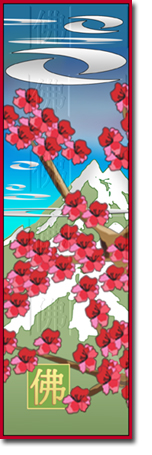On The Way: The Daily Zen Journal
Treatise on Sitting Meditation
Daikaku (1213-1279)
Question: The essence of sitting meditation is the nonproduction of a single thought; trying to stop thought by thought is like washing blood with blood—what should we do?
Daikaku: The nonproduction of a single thought is what is known as the original essence of the mind. It is not stopping thought, yet it is also not not stopping thought; it is just the nonproduction of a single thought. If you merge with this original essence, this is called the realization of thusness of the reality of things. Thus, even sitting meditation is no use here—there is no illusion, no enlightenment, so how could there be thoughts?
If you do not know this original essence, you cannot help but produce thoughts; even if you suppress them so they don’t arise, this is all still ignorance. It is like a rock lying on the grass; before long the grass will grow again. You should work on meditation most meticulously and carefully; don’t take it easy.
Question: Some say we should turn to the point where not a single thought is born; what about this?
Daikaku: The nonproduction of a single thought is an expression referring to complete absence of any signs of birth, extinction, going, or coming. Birth and death come from the mind: if you don’t know where thoughts come from, you cannot know the root of birth and death. Sentient beings are constantly afflicted by lustful, angry, foolish thoughts which compel them, making them turn away from their inherent nature.
If the clouds of delusive thought clear, the moon of the nature of mind appears; the thoughts you hated before then become knowledge and wisdom, and you can use these thoughts to talk about reality and teach sentient beings. An ancient said, “You people are used by the twenty four hours; I make use of the twenty four hours.”
Question: You say that when sitting in meditation, it is wrong when thoughts arise, yet wrong to stop them—so then what?
Daikaku: Before you have seen reality, creating and stopping thoughts are both wrong. It says in the Buddhist scriptures sometimes not to create false ideas, and sometimes it says not to cease and pass away. These are words to let us know the fundamental reality. If you know fundamental reality, then cultivation of practice is not necessary. When the disease of illusion and delusion is removed, then there is no more use for cures. Even so, when the disease of delusive feelings arises, then you need the cure of cultivation of practice. Thoughts arising is the disease; not continuing is the medicine.
Question: Even if thoughts arise, they have no reality of their own; what is wrong?
Daikaku: Even though they have no reality of their own, as soon as they arise you go wrong. It’s like things in a dream—when you awaken you realize they were unreal; were you not mistaken? That which makes mistakes and produces dreams is sentient beings’ false views. One day if they hear a teaching of enlightenment and are inspired with faith, this is much better. Even so, those who do not have a really genuine aspiration for enlightenment do not realize the errors of their minds because their application of effort is not careful.
Even though from time to time they suppress small thoughts, they are not aware of the big thoughts. If you do not cut off the root source, even if you have some affinity with the way, it will be impossible to escape birth and death.
Question: The sixth patriarch said: “Do not think any good or bad at all.” To have no thoughts about good or bad surely is the essential point of sitting meditation; what are little thoughts and big thoughts?
Daikaku: “Do not think any good or bad at all” are words that cut through directly; not only in sitting meditation are they to be applied. If you reach this state, walking, standing, sitting, and lying down are all meditation; no need to cling to the form of sitting.
A patriarch said, “Walking is also meditation; sitting is also meditation; speaking, silent, active or still, the body is peaceful.” One of the Buddha’s discourses says we are always in it, walking around, sitting, lying down.
Little thoughts are thoughts that suddenly arise about what is before you. Big thoughts are thoughts of things like greed, hatred, folly, false views, conceit, jealousy, name and fame, profit, and support. When sitting in meditation, those whose wills are weak may keep back little thoughts, but such evil thoughts as these big ones will remain unawares in their minds. These are called big thoughts.
Giving up these big bad thoughts is called directly cutting off the root source; afflictions become enlightenment, folly becomes wisdom, the three poisons become the three bodies of pure discipline, ignorance becomes the objective reality of great knowledge—need we speak of little thoughts?
Buddha said, “If you can transform things, you are the same as those who realize thusness.” That’s what this means. If you can transform things, don’t be transformed by things.
Question: “If you can transform things, you are the same as those who realize thusness”–what are things, what is transformation?
 Daikaku: Things are everything; transformation is complete liberation. Transforming things means that your mind is immutable in the midst of all things, turning back to fundamental nature, objects do not hinder the mind. Heavenly demons, ghosts and spirits, afflictions, birth and death cannot overcome you. This is call transforming things.
Daikaku: Things are everything; transformation is complete liberation. Transforming things means that your mind is immutable in the midst of all things, turning back to fundamental nature, objects do not hinder the mind. Heavenly demons, ghosts and spirits, afflictions, birth and death cannot overcome you. This is call transforming things.
The essential point to watch is not to shift your mind onto things. Even views of Buddha and Dharma should be cut off, to say nothing of false thoughts; although the cutting mind seems like the thinking mind, this is right thought, and right thought is called wise thought. This is the knowledge and wisdom which enters into right seeing.
Question: It is clear that afflictions and enlightenment come from the mind, but just where do they begin?
Daikaku: Seeing forms, hearing sounds, smelling odors, tasting flavors, sensing feelings, cognizing phenomena, are the functions of the powers of the six faculties; among these sense fields, that which distinguishes good and bad, discriminates false and true, is wisdom. Herein to set up others and self, producing love and hate, all are wrong views; development of attachment to forms based on these wrong views is called delusion, and from this delusion arise matter, sensation, perception, coordination, and consciousness—the five clusters—this is called affliction.
Because sentient beings’ physical bodies are built of afflictions, they indulge in murder, theft, adultery, falsehood, and other evil actions, and eventually degenerate into evil paths. All this comes from wrong thoughts; as soon as these wrong thoughts arise, if you can turn them right around toward fundamental reality, then you can attain mindlessness. Once you rest in no mind, then the five clusters become the five-element body of reality of those who come to realize thusness. This is called “abiding nowhere, yet activating the mind.” Using your mind in this way is the great function of cultivation of practice.
Question: Someone who has long developed accomplishment at sitting meditation and whose work is pure and mature should not have any afflictions or delusion in his mind; how can those who are just beginning to cultivate practice put an end to afflictions?
Daikaku: Don’t despise afflictions, just purify your mind. An ancient said “To study the way you must be made of iron; lay hold of the mind and it’s settled. Directly approaching unexcelled enlightenment, don’t worry about any right or wrong.” Laying hold of the mind means judging if the mind is in a proper state or not; those who know their minds’ errors are wise ones, and those with wisdom should not be deluded.
It is like taking a lamp into a dark cave where sunlight or moonlight has never come in; the old darkness doesn’t go outside, but suddenly it becomes light inside. With the light of wisdom, the darkness of ignorance and affliction don’t have to go away to be gone. At night the sky is dark, but when the sunlight comes out, the sky becomes daylight. The mind is also like this; illusion is darkness, enlightenment is light—when the light of wisdom shines, the darkness of affliction suddenly turns light. Enlightenment is not something separate.
Daikaku (1213-1279)
Excerpted from The Original Face: An Anthology of Rinzai Zen-trans and ed by Thomas Cleary 1987





As abstruse as some of these pieces sound, there are always concrete points of practice that shine through. That doesn’t mean it doesn’t take some real contemplation to find the hidden kernel that is just the point to spur on our practice.
Dealing with thought and reining in the mind takes immense strength of mind. One of the six perfections in Buddhism is virya, variously translated in several ways, but the one I relate to the most is the strength of character, devotion to the Way, or even physical strength and energy it takes to keep on track.
In the beginning, our sitting practice is where we return and remember. It often seems to be in a different realm of time and space to daily life. To bring our sitting into our daily actions, many of us focus on a point in training like patience, another one of the perfections, to avoid automatically responding to a situation or a person. This is where at first it takes real effort to rein in our conditioned response. After a while, though, that calm non-reactive spaciousness feels more like home than the personality of us, which seems like a character we are playing in life.
Buddha said, “If you can transform things, you are the same as those who realize thusness.”
So we take in our perceptions and instead of some machine like programmed response, there is recognition of a freedom in how we respond. We can choose an ordinary limited way or take the energy, transform it in the eye of awareness, and return with a more relaxed non-reactive mind.
That recognition and ability to see comes from meditation and an aspiration to live out the principles of wisdom. This doesn’t mean every action and every word comes from the highest mind possible. It does mean that we see this as a real possibility and aspire to live more from that heart/mind. And every time we remain centered and fixed in this way builds the strength or virya to be able to repeat this again and again.
Once we taste the possibility of living this, we become responsible for manifesting it again and again. These are not dead words from the past; they raise a challenge to us in the present to actualize what they represent. This awareness and life of action only continues through those of us who take up the path of practice, not just on the cushion or in a retreat, but in everyday life.
Sending courage to be the present unfolding,
Elana, Scribe for Daily Zen